April 2025
The global bioburden testing market size accounted for USD 1.51 billion in 2024, grew to USD 1.73 billion in 2025 and is projected to surpass around USD 5.80 billion by 2034, representing a healthy CAGR of 14.40% between 2024 and 2034. The North America bioburden testing market size is calculated at USD 540 million in 2024 and is expected to grow at a CAGR of 14.45% during the forecast year.
The global bioburden testing market size is calculated at USD 1.51 billion in 2024 and is predicted to reach around USD 5.80 billion by 2034, expanding at a CAGR of 14.40% from 2024 to 2034. The demand for the bioburden testing market is rising due to concerns regarding food quality. Companies are adopting these procedures which ensure the food quality that also gains the public trust and increases the reliability.
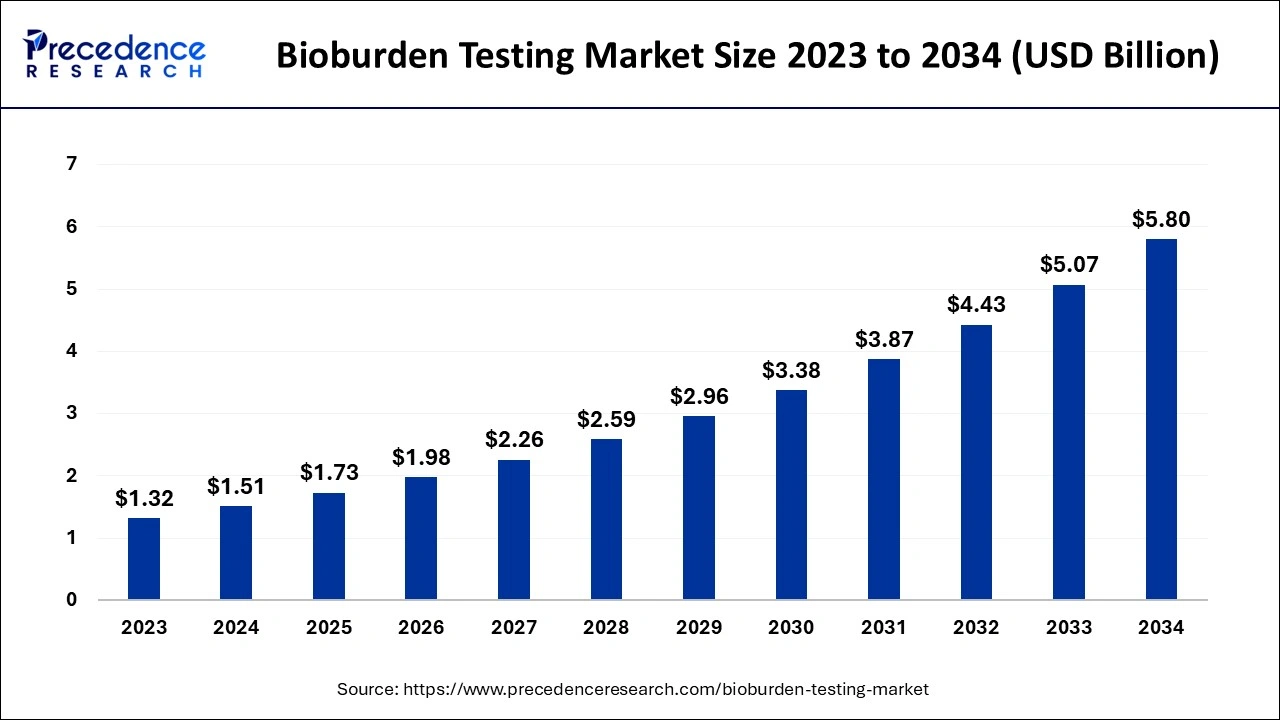
The U.S. bioburden testing market size is evaluated at USD 460 million in 2024 and is expected to be worth around USD 1,800 million by 2034, growing at a CAGR of 14.65% from 2024 to 2034.
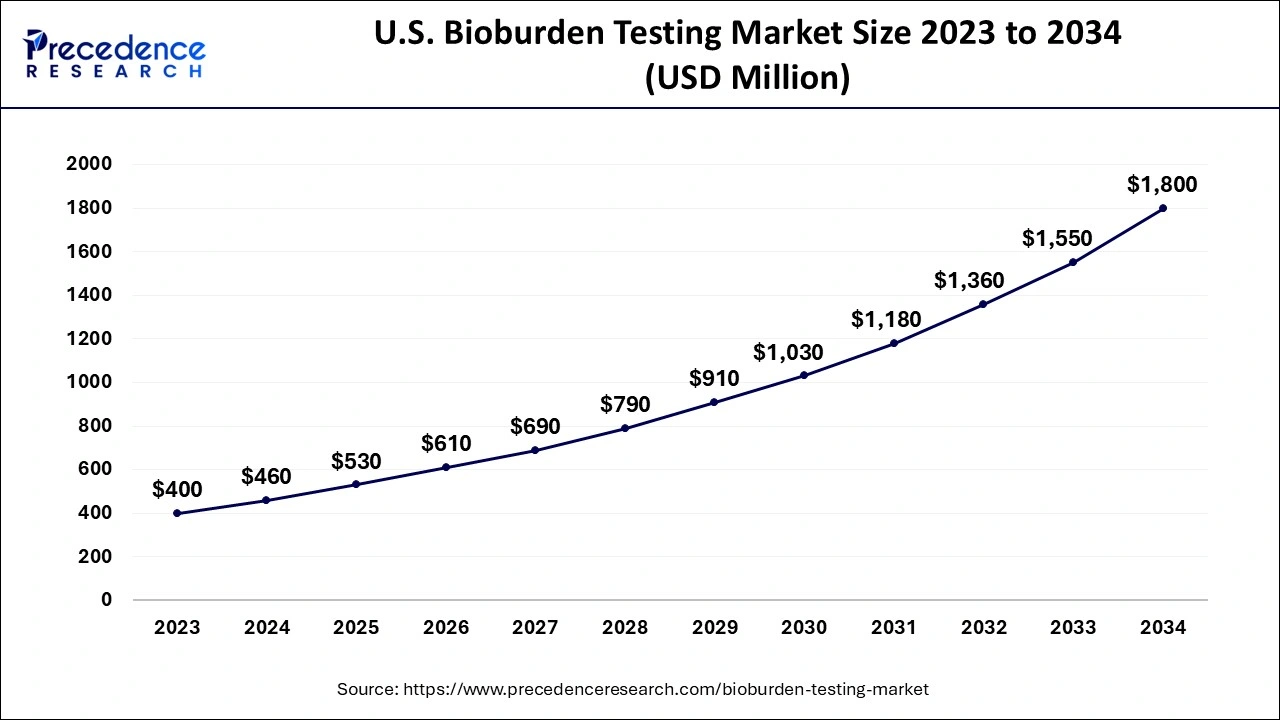
North America dominated the global bioburden testing market by contributing to the highest revenue share in 2023. The dominance of the region is attributed to the advanced healthcare facilities in countries like the United States and Canada. These government are increasing their investments towards R&D activities, which is providing opportunities to the new market players. Furthermore, North America is also one of the major players in biotech production, which is creating more opportunities in the bioburden market. The rising focus on production is anticipated to expand their business globally.
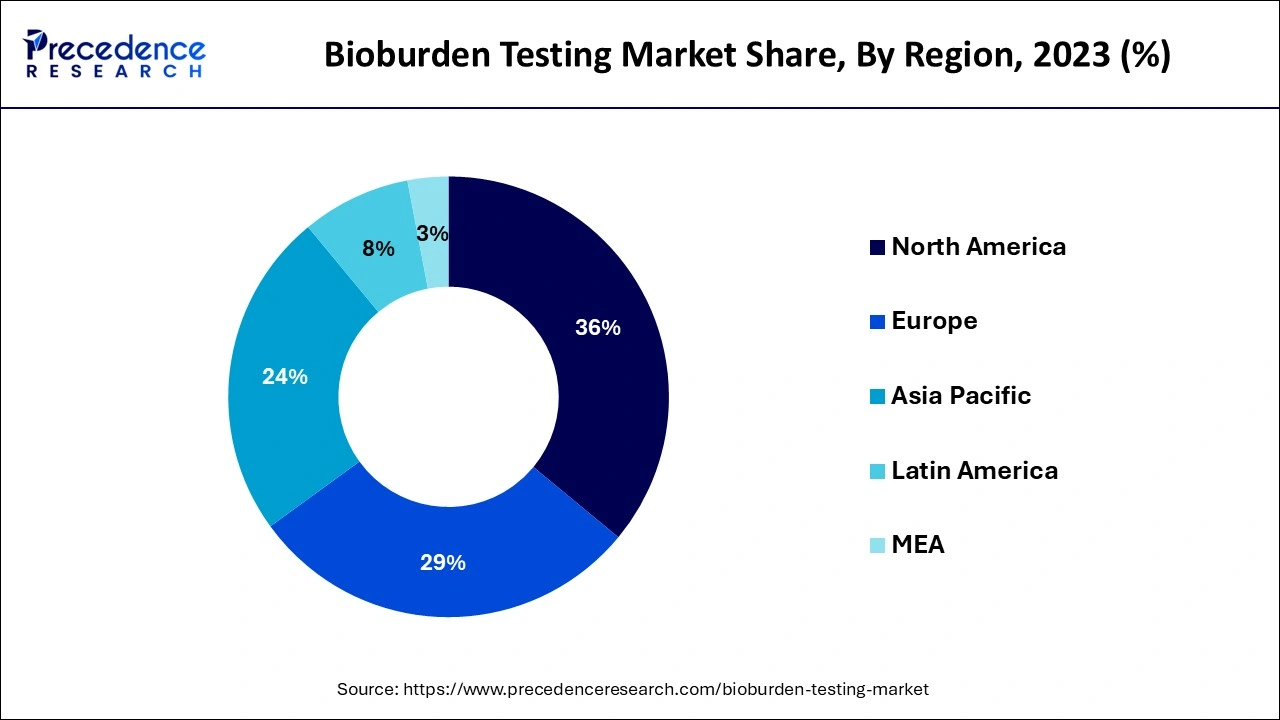
Asia Pacific is anticipated to grow significantly in the market during the forecast period of 2024 to 2034. The growth of the region is attributed to the expansion of the pharmaceutical sectors which are exporting drugs on a large scale. Additionally, the bioburden testing market in India, China, and Japan is driven by the increasing regulatory standards in the food manufacturing sector.
Bioburden testing is a quality control process that looks upon the assessment of microbial contaminations like yeast, bacteria, and other microorganisms present in a product. The bioburden testing market looks upon this testing in pharmaceutical, food manufacturing, and medical devices industries, where the presence of these contaminants can lead to potential risks. The bioburden testing market includes various procedures like sample preparation, cultivation, identification, and others, which work on different aspects to pinpoint the contamination. The process uses different methods like membrane filtration, pour plating, and direct inoculation, which focus on testing in various applications. Companies are adopting these tests as they contribute to the sterilization processes by ensuring effective outcomes.
What is the Role of AI in the Bioburden Testing Market?
The innovation of technologies like artificial intelligence (AI) and machine learning (ML) is playing a transformative role in the bioburden testing market. AI algorithms play a crucial role in identifying microbial contaminations without the need for human intervention. These technologies are gaining reliability as they are providing effective outcomes that reduce the risk of human errors.
AI's capability to analyze real-time data can play a crucial role in providing insights that can be used to enhance the overall process. Additionally, the growing adoption of AI in the bioburden testing market is anticipated to work efficiently in predictive maintenance, which can detect contaminations before they become severe. The growing adoption of ML algorithms is anticipated to innovate new methods for microbial detection.
| Report Coverage | Details |
| Market Size by 2034 | USD 5.80 Billion |
| Market Size in 2024 | USD 1.51 Billion |
| Market Size in 2025 | USD 1.73 Billion |
| Market Growth Rate from 2024 to 2034 | CAGR of 14.40% |
| Largest Market | North America |
| Base Year | 2023 |
| Forecast Period | 2024 to 2034 |
| Segments Covered | Product, Test, Application, End-user, and Regions |
| Regions Covered | North America, Europe, Asia-Pacific, Latin America and Middle East, and Africa |
Expansion of the pharmaceutical industry
The rising prevalence of new viruses and diseases has played a vital role in the development of the pharmaceutical industry. The bioburden testing market is growing significantly due to the rising demand for new drugs and biologics that are used to cure various diseases. These factors have led to the rising developments in drug testing as the demand also raises the competitiveness in the market. The rising demand also stands out as a major factor, as it provides multiple business opportunities for manufacturing facilities.
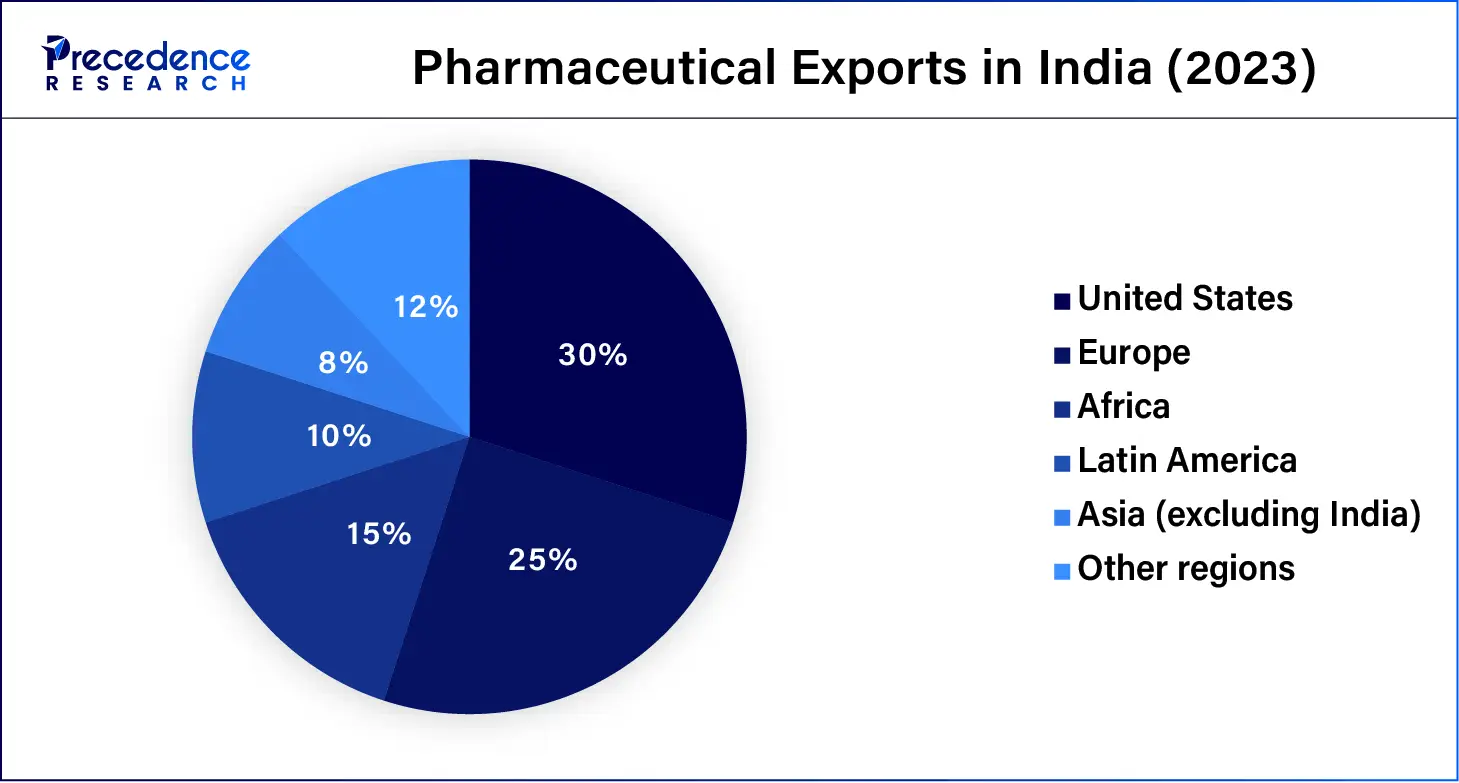
Increasing food safety standards
The growth in urbanization has led to the innovation of multiple food products and items, which has attracted tons of consumers. This has also led to many regulations that are benefiting the bioburden testing market due to the rising regulatory requirement for food products. Additionally, the rise of social media has played a vital role in increasing awareness of high-quality foods. Many companies are using these tests to meet the FDA and other standards that make the product applicable for sales. The changing lifestyle dynamics have led to the adoption of more packaged food, which requires a higher level of bioburden testing.
Technology limitations in underdeveloped regions
The use of bioburden testing has significantly increased in developed regions where there are numerous business opportunities, but there are still some factors that tend to hamper the growth of the bioburden testing market. These processes often require advanced technologies, which contain higher costs and require higher initial investments. This creates financial restraining for the underdeveloped regions which can restrict its demand. These factors vitally affect their healthcare and food industries.
Stricter government regulations
The pharmaceutical and food manufacturing industries have shown magnificent global growth, which has resulted in competitiveness in the respective industries. The bioburden testing market stands out as an impactful player that can provide testing solutions in these industries. The rising growth also raises the regulatory standards, which focus on the rules and regulations. The growth of the medical device sector is more sensible; thus, it attracts multiple investments from governments, which can help the market growth. Additionally, the rising concerns regarding public health are expected to attract more government investments in the food and beverage industry.
Increasing focus on R&D
The rapid technological advancements have led to many changes like rapid result-oriented industries. Thus, the bioburden testing market is gaining significant attention due to the rising need for faster and more accurate testing methods which can help make rapid changes in industries like food manufacturing and medical devices. Additionally, there are rising risks of microbial contamination in the biopharmaceutical industry.
The consumables segment contributed the largest share of the market in 2023. Consumable in the bioburden testing market refers to the substances and chemicals that are used during the testing process. Some of the consumables are reagents and media, Petri dishes, and test kits. The dominance of the segment is attributed to the rising testing process across various industries. The wider user base of these consumables has led to bulk production, which also makes them more cost-effective than the other products. Additionally, the rising use of consumables in various applications like food and beverages and pharmaceuticals is anticipated to bring more business opportunities.
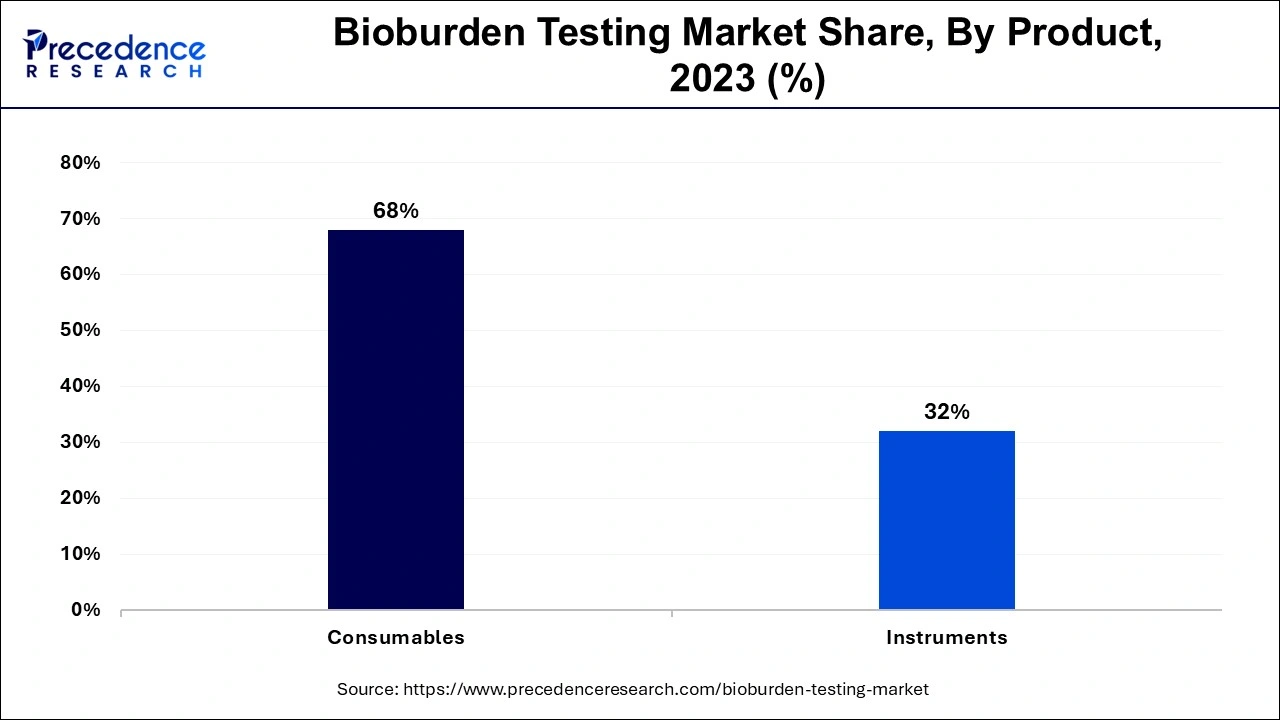
The instruments segment is anticipated to grow at a significant CAGR in the market during the forecast period of 2024 to 2034. Instruments in the bioburden testing market refer to systems like microbial testing systems, flow cytometers, PCR Machines, and others that perform and analyze bioburden tests. The growth of the segment is attributed to the rising automation in these tests, which increases work efficiency without human intervention. Additionally, rapid technological advancements are contributing to the adoption of rapid testing systems.
The aerobic count testing segment stood dominant in the market in 2023. The test is used to measure microorganisms like bacteria and fungi that are usually found in oxygen-rich environments. The dominance of the segment is attributed to the widespread use of these organisms, which contributes to the growth of the bioburden testing market. The wide consumer base of the food industry and pharmaceuticals is one of the major players that is boosting the market growth where testing providers are providing these services at cost-effectiveness.
The anaerobic count-testing segment is anticipated to grow significantly in the market during the forecast period of 2024 to 2034. The test is used to measure microorganisms in oxygen-less environments. The bioburden testing market is growing significantly due to the rising regulations in the healthcare industry where these tests are playing a vital role in ensuring patient safety. Additionally, the market is grown by the rising initiatives in the food manufacturing industry where they are focusing on increasing food safety by implementing these tests.
The raw material testing segment led the global market in 2023. The bioburden testing market is growing efficiently due to the rising use of raw materials in the manufacturing of food products, medicines, vaccines, etc. These tests are performed on a large basis to ensure that the devices are free from microbial contamination. The companies are adopting these tests to ensure quality control in their production, which opens many opportunities for the testing solution providers. Additionally, the rising focus on regulatory guidelines in cosmetics manufacturing is anticipated to bring more opportunities.
The medical device-testing segment is anticipated to grow at a significant CAGR at the market during the forecast period of 2024 to 2034. The dominance of the segment is attributed to the rising global demand for medical devices. This stands out as a major growth factor that drives the growth of the bioburden testing market. The rapid expansion of the sector has led to an increasing focus on safety standards, which has led to the adoption of microbial testing. Additionally, the rising investments in the healthcare sector are anticipated to innovate more automation systems that can be crucial in the growth of medical devices.
The pharmaceutical and biotechnology companies segment registered the highest share of the market in 2023. These companies mainly focus on the production and commercialization of medical drugs and biotechnology-based products in the market. These companies perform advanced testing to ensure the quality of the products, which also helps enhance the brand image and value. The bioburden testing market is growing efficiently due to the higher testing volumes in these companies, which provides multiple opportunities for the solution providers. Additionally, the market is attracting more investments in R&D due to the expansion of supply chains.
The contract manufacturing organizations is anticipated to grow at the fastest CAGR in the market during the forecast period of 2024 to 2034. The growth of the segment is attributed to the expansion of manufacturing outsourcing by the companies that drive the bioburden testing market growth. The expansion of these services is providing more opportunities globally.
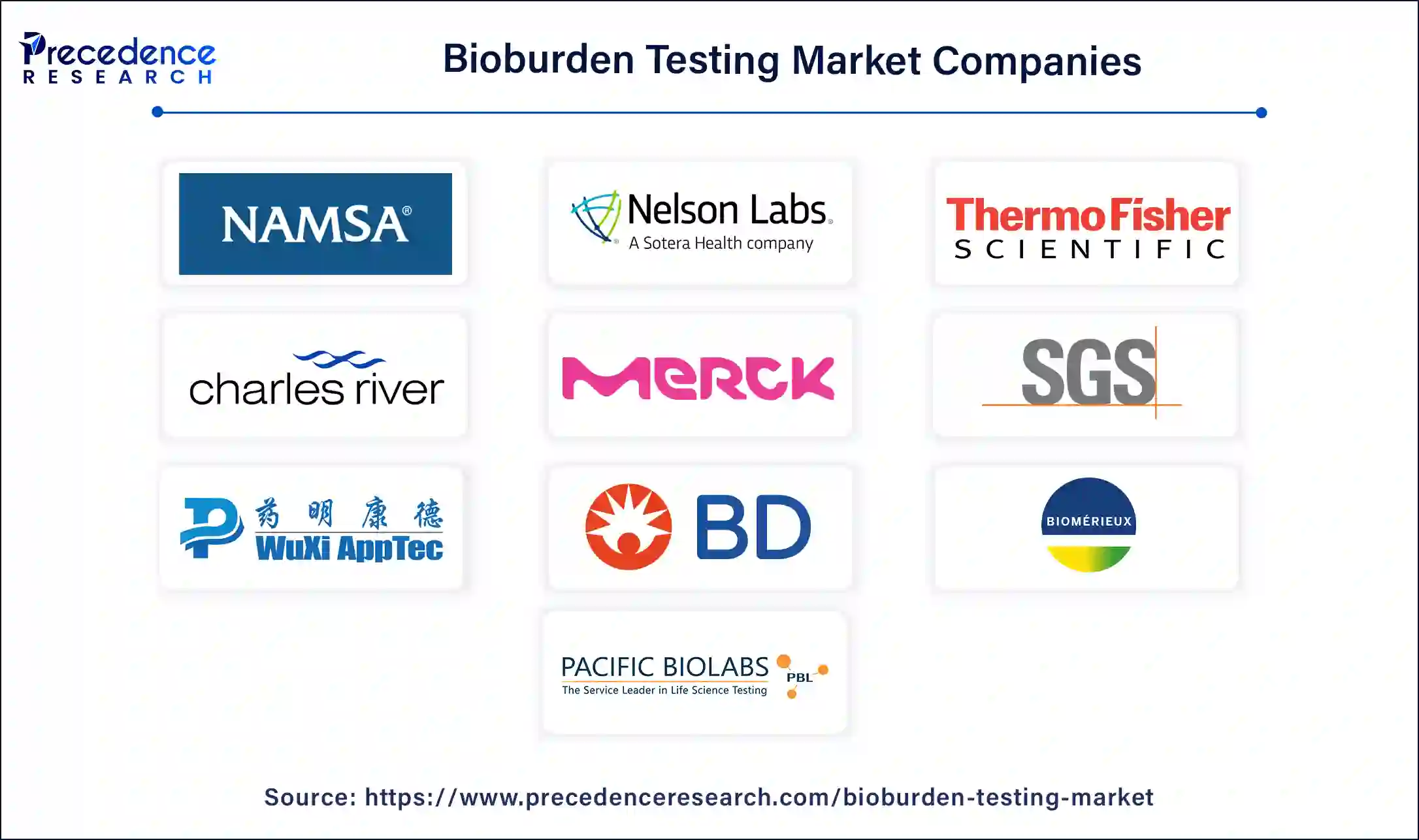
By Product
By Test
By Application
By End-user
By Geography
For inquiries regarding discounts, bulk purchases, or customization requests, please contact us at sales@precedenceresearch.com
No cookie-cutter, only authentic analysis – take the 1st step to become a Precedence Research client
April 2025
February 2025
December 2024
February 2025